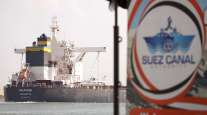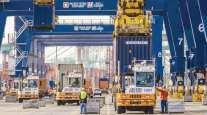Developers Revive Cold-Storage Facility Plans in Maine

[Stay on top of transportation news: Get TTNews in your inbox.]
A hotly anticipated plan for a waterfront cold-storage warehouse is back on the table in Portland, Maine.
A consortium of private developers submitted plans to the city last week to build a 120,000-square-foot, temperature-controlled building on state-owned land at the International Marine Terminal. The new proposal calls for a building that would be 75 feet tall at its peak, just within the current zoning limit.
The proposed building, called the Maine International Cold Storage Facility, is expected to meet the refrigerated cargo demand of Icelandic shipping company Eimskip and be big enough to accommodate customers from Maine’s growing food, beverage and biopharmaceutical industries, said George Campbell, chairman of Treadwell Franklin Infrastructure, the Yarmouth, Maine, developer fronting the plan.
“This can serve the entire state of Maine in extraordinary ways,” said Campbell, a former Maine transportation commissioner.
The Maine Port Authority has wanted a cold-storage facility at its only container terminal in Portland for years. Eimskip and Atlanta-based Americold Realty Trust, a major cold-storage developer, planned to build a facility five years ago, but Americold later dropped out following a two-year city zoning process to allow tall, bulky buildings at the port. In 2017, height limits in the zone were increased from 45 feet to 55 feet, and up to 75 feet for buildings specifically connected to marine industries that meet certain conditions. Americold ultimately walked away from the project, saying that after considering the regional economics, construction costs and industry analysis, it had concluded that the cost to operate a state-of-the-art, temperature-controlled facility at the waterfront would not meet its underwriting criteria.

A view of the Casco Bay Bridge in Portland, Maine. (Getty Images)
Americold ranks No. 17 on the Transport Topics Top 50 list of the largest logistics companies in North America.
Early this year, Eimskip, which still had an active bid to develop the project, selected Treadwell and Amber Infrastructure Group, an international development and fund management company, to lead the project, Campbell said. Amber, which manages a $14 billion portfolio of energy, hospital, school, transportation and other facilities, would own the building and hire a company to run it.
The total cost of the building is subject to its final design, but is estimated to be $25 million to $30 million, Campbell said. It would be funded with borrowing and private equity from Amber.
The Port Authority board of directors last month agreed to a lease of up to 50 years for the building. The owner would pay at least $100,000 a year in rent for the first seven years and $200,000 in the next seven years, but that could increase to $500,000 a year or more depending on the volume of cargo through the facility.
The Maine Department of Transportation has budgeted $8 million to pay for foundation work and building design.

Nass
“I think we are in a sweet spot — this is going to happen,” said Jon Nass, CEO of the Maine Port Authority, adding that the facility would improve export opportunities for Maine businesses and encourage more shipping companies to use it. “We think a cold-storage [facility] on site here will make this a competitive port for decades to come.”
Renderings of the proposed building show a large, boxy, white structure sited along Commercial Street west of the Casco Bay Bridge. The proposed building would have space for approximately 20,000 pallets, 12 loading dock bays, 76,000 square feet of freezer space and room for rooftop solar.
“I’m excited for the state of Maine that this project is moving forward,” Portland Economic Development Director Greg Mitchell said.
The city went through an extensive zoning process to modernize its port, and the project should comply with land-use requirements, he said.
“My expectation is that it can move through the planning board process at a normal pace,” Mitchell said. “We’ve been anxiously awaiting an opportunity for a cold-storage project to complete the infrastructure investment we need for an active port with cargo shipping.”
Changing the zoning involved more than a year of public engagement amid fierce opposition from some residential neighborhoods in Portland’s West End. Campbell said the building fits the zoning requirements and he doesn’t expect it to stir up the same controversy the previous proposal did. It is the company’s responsibility to respond to any concerns, he added.
“I think the public has every right to expect answers from us about how we are respecting the requirements laid out by the community, and we will tell them,” Campbell said.
Compare each of the presidential candidates' plans for addressing America's infrastructure needs. See our Candidate Infrastructure Tracker.
Eimskip and its clients would use up to 40% of the pallet space, Campbell said. He expects excess capacity to be filled quickly by companies in Maine and elsewhere that want storage for perishables intended for export.
In the past decade, Maine has invested heavily to make its only container port competitive, spending $64 million on new cranes, container space, buildings and other equipment.
The investment appears to have paid off — freight volume through the Portland terminal has grown by an average of 25% annually since Eimskip began making trips seven years ago. In 2019, more than 28,600 container units transited Portland, quadruple the volume in 2013.
Portland is the western anchor of a shipping line that runs to Nova Scotia, Newfoundland and Iceland, with connections to Northern Europe. In 2017, Eimskip added weekly stops, and last year larger ships to its run and transshipment opportunities in Halifax, Nova Scotia, with French shipping giant CMA CGM. Transshipment is when cargo is shipped to an intermediate destination, then to another destination.
The planned building could be divided into cold and dry storage areas to accommodate a variety of customers, and initial analysis indicates it is “right-sized for this market and can offer some good opportunities,” Campbell said. Sterling Solutions, a cold-storage and logistics company, is conducting the design and demand analysis of the facility.
Want more news? Listen to today's daily briefing:
Distributed by Tribune Content Agency, LLC




